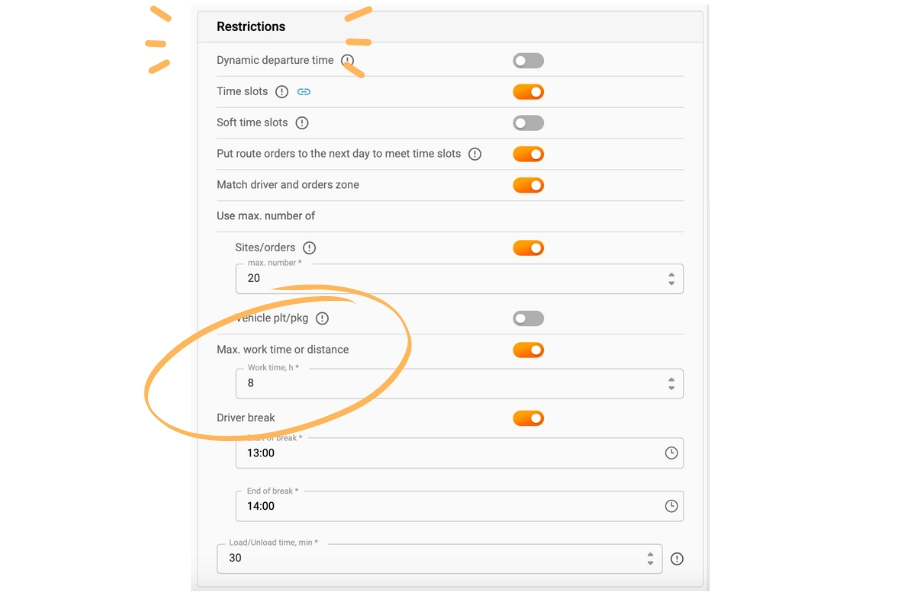2024 guide to the 34-hour reset for drivers

by
Alina Kostukova
March 20, 2024
The Federal Motor Carrier Safety Administration (FMCSA) introduced the 34-hour reset rule because they know how important rest is for keeping drivers safe on our roads.
This rule isn't just unnecessary paperwork; it's a carefully made plan to fight against driver tiredness, which is a big danger to road safety.
Driving large trucks requires a lot of focus, similar to flying planes. However, truck drivers often have tough schedules that can make them too tired to drive safely. The 34-hour reset rule gives drivers a long break to rest well and be less likely to drive drowsy.
In this article, we'll explain this vital rule clearly and give practical advice on following it properly. This way, we help make our highways safer by focusing on these key safety steps.
Jump to the most relevant part:
Understanding the 34-hour reset
The 34-hour reset is an extended rest period for truck drivers, allowing them a substantial break from their driving duties. This mandated downtime is crucial for driver well-being and road safety, allowing them to recuperate through relaxation or sleep within their trucks.
Such breaks are vital in preventing fatigue-induced impairments in attention and reaction times—common risks associated with prolonged driving. Essentially, this reset acts similarly to pausing during a race to regain strength; it ensures that drivers remain vigilant and responsive when on the road.
Therefore, encountering a truck post-reset suggests its driver has been rejuvenated, enhancing overall safety for all road users.
Benefits of the 34-hour reset for drivers
The 34-hour reset is a rule and offers several benefits for drivers and trucking companies. Here's how:

Enhanced alertness and vigilance
After taking a 34-hour break, drivers feel refreshed and more alert. This helps them quickly notice and respond to dangers on the road, significantly reducing accidents caused by being tired.
By staying fully alert, drivers make the roads safer for everyone. This follows safety rules and shows their commitment to driving safely.
Improved decision-making
Being tired dramatically affects how well our brains work, making it hard for drivers to make good choices. If drivers don't get enough sleep, they may not pay attention as well and could react slowly, raising the chance of mistakes or poor decisions.
However, getting proper rest through something called a 34-hour reset is critical to avoiding these problems.
By getting enough sleep, drivers can think clearly again and handle tricky situations better on the road. This refreshed feeling helps them make safer choices, making everyone on the road safer.
Strengthened regulatory compliance
Following the 34-hour rest rule shows a solid commitment to following rules and keeping everyone safe. By sticking to these required breaks, drivers maintain a good reputation in their field and build a responsible work environment.
This dedication makes sure they meet legal requirements and highlights how important safety is in transport, helping to make the industry more professional and trustworthy.
Reduced stress and burnout
Taking regular breaks helps drivers relax, refresh, and deal with work stress. This way of managing stress before it gets too much can prevent them from feeling too tired or unhappy with their jobs.
When drivers rest and care for themselves, they become stronger over time and able to handle the demands of their jobs. This leads to a happier and more influential group of workers in the transportation field.
Benefits of implementing the 34-hour reset for companies
Putting a 34-hour rest period rule in place brings many good things for businesses, going beyond just following rules to create a safe, efficient, and worker-friendly environment.
First off, sticking to this rule shows a solid dedication to keeping things safe. This makes everyone involved with the company trust that it runs safely and cares about its people.
By ensuring drivers get enough rest and manage tiredness well, companies lower the chance of accidents. This protects both people's lives and the company's money.
This makes the business more productive and keeps customers happy because their deliveries arrive on time and without issues.
Also, following the 34-hour break rule shows that companies keep up with essential safety practices. It helps them manage driver fatigue better, staying ahead of any new regulations and setting themselves apart as safe and reliable in transport.
In short, a 34-hour break rule does more than just enforce rules; it improves safety, work efficiency, and employee happiness and sets a high standard in transportation safety.
How to properly implement the 34-hour reset?
Ensing truck drivers use the 34-Hour Reset correctly is key to keeping them safe and following rules. Here's an easy guide on how to best use this important rule:Review the previous workweek: Review your last workweek to determine the best time for your 34-hour break. Consider how many hours you drove, when you took breaks, and what deliveries are coming up.
- Pick a start time: Choose a good time to start your 34-hour break. This could be right after you finish driving or whenever you usually like to rest.
- Count 34 hours: After picking when to start, count forward 34 hours straight. Ensure this block of time is all for resting without interruptions so it follows the rules.
- Write it down: Record the beginning and end of your 34-hour break in a paper logbook or an electronic logging device (ELD). This is important to show that you're following the law and keeping accurate records.
- Start driving again: Once your 34 hours are up, you can return to driving. Before hitting the road again, ensure you've had enough rest and are sticking to driving hour limits set by regulations.
Common myths of the 34-hour reset
Confusion about the 34-hour break rule can cause problems with following laws, increase accidents due to tiredness, and lead to legal issues. Drivers need to understand the actual information for their safety and ensure they follow the rules correctly.
Clearing up these false beliefs and teaching drivers helps them follow the rules better and creates a safer work environment. This cuts down on dangers and makes things run more smoothly.
Let's address these misconceptions to ensure smooth and compliant operations. Here are some common misconceptions:
Myth 1: Splitting the reset
Reality: Remembering that the 34 hours must be straight through is key. You can't break it up into shorter pauses to begin your time over again.
Myth 2: Short breaks don't count!
Reality: Taking short breaks for eating or personal reasons counts as work time and doesn't count towards your break period.
Myth 3: The "anytime" reset
Reality: Keep in mind that when you reset, it only refreshes your 7 or 8-day work period, not the whole week. It's really important to think carefully about when to do your resets to get the most out of them.
Recent changes and updates to the 34-hour reset rule (as of 2024)
Important changes to the rule allowing truck drivers to rest for 34 hours to reset their work week will take effect in 2024.
Here's what it means:
- The Department of Transportation says truck drivers should not drive if they have worked 60 or 70 hours over the last 7 or 8 days.
- However, if drivers take a 34-hour break and spend this time not working or sleeping in their trucks, they can start their workweek again from zero.
- This helps them stay within the allowed driving hours each week.
The 34-hour restart rule involves various Hours of Service (HOS) statuses: off-duty, on-duty, driving, and sleeper berth.
Drivers driving or on duty can work up to 60 hours in seven days or 70 hours in eight days.
To take their 34-hour break, drivers should either:
- Consume the hours continuously by going off duty.
- Divide the eight hours of sleeper berth time into two periods, each lasting at least 2 hours.
- After completing the 34-hour break, the driving cycle is reset, allowing drivers to resume work as a new cycle of the workweek begins.
Mastering the 34-hour reset: overcoming challenges and maximizing efficiency
Overcoming challenges and maximizing efficiency within the confines of the 34-hour reset demands strategic planning and proactive problem-solving.
Here are strategies to consider while navigating the challenges and opportunities of mastering the 34-hour reset:
Scheduling conflicts
Sometimes, planning when to deliver things can get tricky because of strict deadlines, unexpected hold-ups, or clashes with personal plans. This problem is serious as it might break the rules about working hours and put drivers at risk. It could also cause money issues for transport companies and mess up the flow of goods.
To avoid these problems, talking clearly with the people organizing deliveries and customers is essential to ensure schedules are safe and follow the rules.
Various software solutions, such as route planners, can greatly assist in automating driver management, including making sure the 34-hour reset rule is implemented.
For instance, one such route planning solution provider Track-POD, allows setting up driver and vehicle restrictions for the number of miles travelled, sites visited or hours worked to make sure all the delivery operations are according to the law.

Finding suitable rest areas
Looking for good places to take a break can be challenging, especially in far-off or busy spots. This is a big problem because not having enough rest stops can make drivers tired, stressed, and more likely to have accidents.
It might also lead to breaking the rules about how long drivers can drive if they need help finding good places to stop and rest.
To avoid this, plan your breaks ahead of time by using guides for truck stops or apps that tell you about what facilities they offer, how many parking spots there are, and how safe they are.
Use the rest areas set up by road authorities and consider other options, such as truck stops, or specific parking areas where rest is allowed.
Adapting to irregular work hours
Truck drivers often work at various hours, such as during the night, on weekends, and holidays. This irregular schedule can disrupt their sleep patterns, exhaust them, and impact their well-being and mood. It could also make it hard for them to manage work and personal time.
Truck drivers should try to sleep well whenever they can to cope with this. They can take quick naps, eat healthy foods, and exercise regularly to help cope with the changing work hours.
Talking to their bosses about when they prefer to work and asking for fair working hours is also a good idea.
Maintaining a consistent sleep schedule
Keeping a regular sleep pattern can be hard because of work, like working for many hours, at different times, and in changing places. This problem is serious as it can mess up your body clock, make you very tired, and affect how well you think. It might also lead to more accidents on the road.
To make sleeping in your truck easier:
- Ensure your sleeping spot is snug and comfy.
- Before sleep, do calming activities like reading or listening to gentle music.
- Keep the area where you sleep dark and quiet. If needed, think about using earplugs or devices that play relaxing sounds.
Compliance with hours of service regulations
Following rules about how many hours drivers can work is very important. It keeps drivers safe, stops accidents caused by being too tired, and helps transport companies avoid getting into trouble.
If these rules aren't followed, there could be significant fines or worse consequences like losing a license to drive professionally or harming the company's good name. You must understand these driving time rules and stick to them strictly—knowing when to drive and when to rest.
Using electronic logging devices (ELDs) makes it easier to keep track of your driving hours accurately and ensure that you're following the rules.
Also, talking openly with the people who schedule your drives about not overloading you with too much work can help maintain a balance between work and rest.
Dealing with unexpected delays or interruptions
Truck drivers often face problems like traffic jams, bad weather, or truck issues that can mess up their delivery times and make their jobs stressful. These problems are serious because they can cause late deliveries, lost money, and dangers on the road.
Drivers need to stay flexible and ready to deal with unexpected situations by focusing on staying safe and figuring out solutions. Talking openly with the people who organize the deliveries is key to informing them about delays and working out different plans.
Drivers should also keep up-to-date with weather reports and traffic news through apps or GPS systems to choose the best roads.
Misunderstandings of the rule
Not fully understanding the 34-hour reset rule can cause problems, including breaking driving hours rules. This is a big issue because it might lead to penalties, fines, and harm to drivers' and companies' reputations, making it harder to keep up with safety and follow the rules.
It's essential to keep up-to-date with changes or new interpretations of these driving hour rules so you understand them. If you need clarification on how the 34-hour reset rule works, ask for more information from officials who make these rules, groups in the industry, or legal advisors.
Drivers and those who schedule their routes should know precisely how to use this rule correctly. Providing resources that help them follow this rule is also a good idea.
Conclusion: supporting driver safety through the 34-hour reset
The 34-hour reset is significant for keeping drivers safe and ensuring they follow the road rules. Even though there are some problems like schedule issues and confusion, there are ways to fix these. Companies can make things better by planning well, talking, teaching their staff, and being flexible.
This helps put driver health first. Drivers and companies need to understand how the 34-hour reset works. They should keep up with driving time rules, get training often, and use electronic tools that help track operating hours correctly.
In trucking, where things constantly change, having drivers who are rested not only keeps them safer but also makes them do their jobs better.
About The Author
Alina Kostukova
Skilled marketing content creator with a background in digital media and public relations. Focused on creating first-rate text and visual content that stands out and tells compelling stories.







